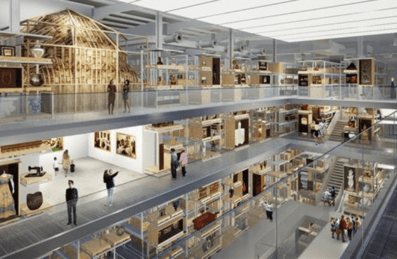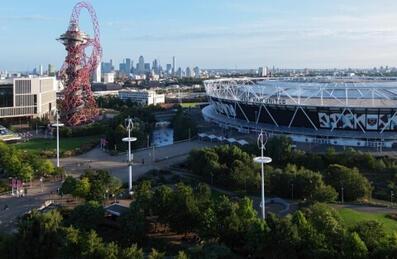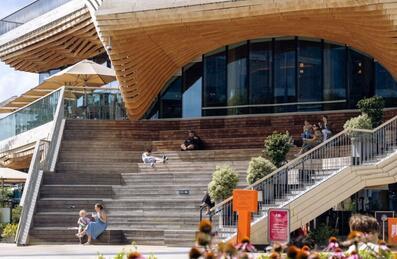
Popular Searches:
Keep up to date
Sign up today for exclusive offers and incredible experiences you won’t want to miss at Queen Elizabeth Olympic Park.
Sign up nowUCL'S TALES OF THE PARK TO BRING TALKING DIGITAL CREATURES TO QUEEN ELIZABETH OLYMPIC PARK
UCL'S TALES OF THE PARK TO BRING TALKING DIGITAL CREATURES TO QUEEN ELIZABETH OLYMPIC PARK
Press Release 07/09/2017
Researchers at UCL’s Centre for Advanced Spatial Analysis (CASA) have created Tales of the Park, a new digital experience for visitors to Queen Elizabeth Olympic Park and the surrounding area. 3D-printed interactive creatures including bees, otters, bats and garden gnomes that you can chat to using your smartphone are now located in a range of locations for people to find.
Funded by PETRAS, a multi-university research hub established to investigate the ‘Internet of Things’, the creatures are intended as a fun way to allow visitors to explore some of the security issues that surround ‘natural language interfaces’ – the same technology used for Amazon Alexa or Facebook Messenger chatbots. As they chat with the creatures, visitors will find out more about Queen Elizabeth Olympic Park and the surrounding area, what events are on, and the fascinating history of the area.
Professor Andy Hudson-Smith, Director of CASA and Principal Investigator on the project, said:
“With Internet of Things devices like Amazon Alexa and Google Home becoming more popular and ‘smart’ assistants appearing on social media, we’re all getting used to talking to our computers and devices. What we don’t know is how much users understand the technology and what it’s doing. Are users aware that some of these devices are always listening, for example, or what sort of information they might be sharing with them?
With our partners at Queen Elizabeth Olympic Park, we’ve worked to create a fun way for visitors to explore some of these issues in the public realm. Our starting point was ‘what if you could give a place a digital “guardian spirit”?’ What would it know about, and what might people want to talk to it about? We hope that visitors will speak to our creatures, find out more about the Park, share their memories of east London - and in the process, we’ll be able to find out more about how people interact with Internet of Things devices.”
Peter Tudor, Director of Venues, Queen Elizabeth Olympic Park, said:
“We’re always looking for new and exciting things to bring to the Park and this is another great way for people to enjoy exploring all that the Park and its brilliant venues has to offer.”
Tales of the Park builds on the existing Tales of Things platform developed in partnership with Edinburgh University and CASA which allows people to share the stories of physical objects using QR Codes. However, Tales of the Park is built with a new technology from Google called the ‘Physical Web’, which uses devices called ‘low energy Bluetooth beacons’ to connect things and places to the internet. If visitors to the Park have the physical web option activated on their Android phone or iPhone and are close to a creature, they’ll automatically receive a notification with a web link that allows them to start chatting with it. All of the activity is free.
Each of the 15 creatures has been named and painted by young people aged between five and twelve, from Academy Achievers, a community organisation based in Newham which helps local children to achieve their potential.
The Tales of the Park creatures are on and around the Park right now waiting for people to find them!
As this is a fun, voluntary game people will only participate if they want to and no phone or personal information will be recorded.
For more information about the project, where to find the creatures and how to interact with the, visit talesofthepark.com or pick up a leaflet in the Park’s venues and information Point.
For press enquiries, contact Dr Duncan Hay at d.hay@ucl.ac.uk or contact the Press Office at Queen Elizabeth Olympic Park on +44 (0) 20 3734 9010 or email press@QueenElizabethOlympicPark.co.uk
NOTES FOR EDITORS
The Physical Web is a new technology from Google that uses simple devices called Low Energy Bluetooth Beacons to connect objects and places to the internet. It's designed to allow people to interact with objects or devices using a smartphone without having to install an app first. To find out more, visit https://google.github.io/physical-web/.
The Centre for Advanced Spatial Analysis
The Centre for Advanced Spatial Analysis is part of the Bartlett, UCL’s Faculty for the Built Environment. Established in 1995, It is an interdisciplinary research institute that focuses on the focuses on the science of cities, drawing upon methods and ideas in modelling, sensing the urban environment, visualisation and computation.
PETRAS
PETRAS is a multi-university research hub funded by the Engineering and Physical Sciences Research Council to investigate Privacy, Ethics, Trust, Reliability, Acceptability and Security around the Internet of Things.
About Queen Elizabeth Olympic Park
London’s newest visitor destination, Queen Elizabeth Olympic Park, is a place unlike any other. Visitors to the Park are able to enjoy beautiful parklands and waterways, world famous sporting venues, arts and events and spectacular views from the ArcelorMittal Orbit. As a new heart for east London, the Park will also provide new homes, jobs and a cultural and education quarter.
The London Legacy Development Corporation promotes and delivers physical, social, economic and environmental regeneration in Queen Elizabeth Olympic Park and the surrounding area, in particular by maximising the legacy of the London 2012 Olympic and Paralympic Games.
For more information visit QueenElizabethOlympicPark.co.uk, follow us on Twitter @noordinarypark and like us on Facebook: facebook.com/QueenElizabethOlympicPark






